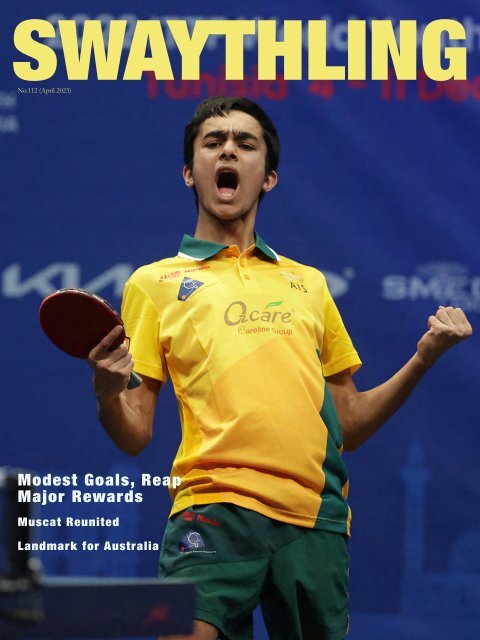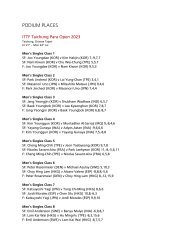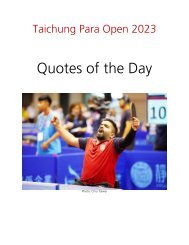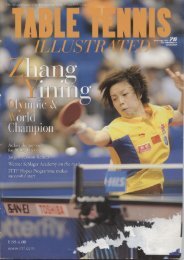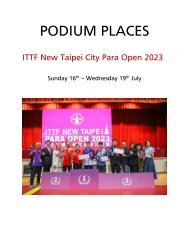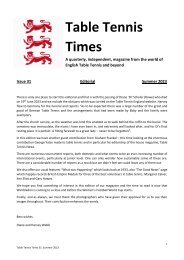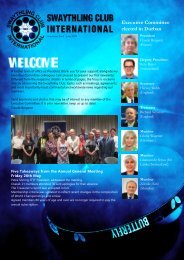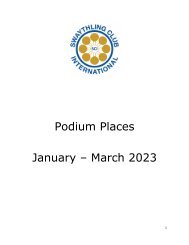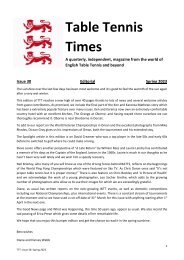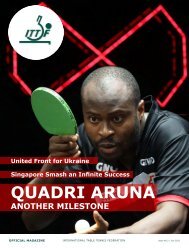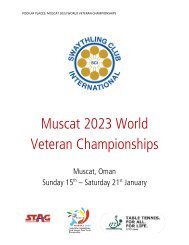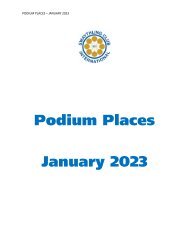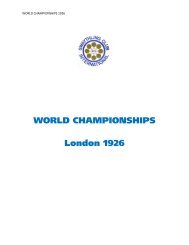Swaythling_Mag_112-1 (2023_04_26)
Create successful ePaper yourself
Turn your PDF publications into a flip-book with our unique Google optimized e-Paper software.
SWAYTHLING<br />
No.<strong>112</strong> (April <strong>2023</strong>)<br />
Modest Goals, Reap<br />
Major Rewards<br />
Muscat Reunited<br />
Landmark for Australia
SWAYTHLING<br />
Issue No.<strong>112</strong> (April <strong>2023</strong>)<br />
Cover: Izaac Quek<br />
Editor:<br />
Ian Marshall<br />
Sub Editor:<br />
Richard Scruton<br />
Statistics:<br />
Michael Theiss<br />
Contents<br />
4. Half a Century Later, Still No Equal<br />
10. Stunning Debut<br />
14. South Africa, Road to Integration<br />
18. Muscat Reunited<br />
24. Impact of Table Tennis on Seniors<br />
28. Jochen Wollmert, Man of Integrity<br />
32. Landmark for Australia<br />
36. Modest Goals Reap Major Rewards<br />
Equipped with Spring Sponge X.<br />
A top sheet with identical technology to that which is used in the Dignics series. And a budget friendly price.<br />
Two variations to choose from, depending on the type of performance that suits your game.<br />
Glayzer and Glazyer 09C.<br />
A new stage of performance helping you fulfill your potential is within reach.<br />
Now experience the effect on your improvement.<br />
Contributors:<br />
Won Bae, Will Bayley, Alica Chladekova, Chuck<br />
Hoey, Eva Jeler, Ina Jozepsone, Dr. Miran Kondric,<br />
Jens Lang, Gaël Marziou, John Murphy,<br />
Chulong Nie, Izaac Quek, Aditya Sareen, Stuart<br />
Sweeney, Jochen Wollmert, Laura Wong, Andris<br />
Zelenkovs<br />
Photographs:<br />
Malcolm Anderson, Alica Chladekova, Rèmy<br />
Gros, ITTF/APAC Sport Media, Gaël Marziou,<br />
World Table Tennis, Jochen Wollmert<br />
Designed by J.T<br />
Attracting Attention<br />
The focus is on performances from totally different eras that have attracted<br />
the attention and raised the eyebrows; turning the clock back<br />
to the 1928 World Championships in Stockholm, Latvia proved a<br />
match for the very best of the era. Turn the clock forward to 2022 and<br />
Australia, a country proud of its sporting heritage but never a major<br />
contender for global honours in the table tennis sphere, reserved a<br />
podium place at the World Youth Championships in Tunisia.<br />
Outstanding achievements, as year after year were those of Germany’s<br />
recently retired Jochen Wollmert, in many eyes the greatest<br />
Paralympian of all; his efforts have stood the test of time, as in a different<br />
manner have those of Slovakia’s Alica Chladekova. Known by<br />
her maiden name, Alica Grofova, she was the women’s singles runner<br />
up at the 1973 World Championships; since that date, Asian players<br />
have always contested the final.<br />
Equally, Alfred Ludwig and Penti Niukkanen caught the eye in Muscat<br />
being ever present at the World Veteran Championships; now attention<br />
turns to Durban and the ITTF World Championships Finals, more<br />
memorable moments await.<br />
Ian Marshall<br />
Keep up-to-date with latest results<br />
<strong>Swaythling</strong> Club World News<br />
World Table Tennis<br />
Podium Places: January – March <strong>2023</strong><br />
NEW Apr. 1, <strong>2023</strong><br />
MADE IN JAPAN<br />
Visit Website<br />
butterfly-global.com/en/product/glayzer/<br />
2 - SWAYTHLING SWAYTHLING - 3
At the time did we realise how<br />
great the achievement? In<br />
those day a European female<br />
player pressing for honours<br />
was not unusual.<br />
Prior to 1973, the only year in<br />
the history of the World Championships<br />
when a European<br />
player had not won a women’s<br />
singles medal was 1965 in<br />
Ljubljana. Conversely, since<br />
that date, only three non-Asian<br />
players, all from Europe, have<br />
gained a women’s singles<br />
podium finish. All bronze medallists,<br />
Tatiana Ferdman for the<br />
Soviet Union in 1975 in Calcutta,<br />
Romania’s Otilia Badescu<br />
in 1993 in Gothenburg and<br />
now two decades ago, Croatia’s<br />
Tamara Boros in 2003 in<br />
Paris.<br />
Medals gained at the European<br />
Youth Championships,<br />
notably junior girls’ team gold<br />
in partnership with Miloslava<br />
Polackova and Ilona Uhlikova<br />
in 1967 in Vejle and the following<br />
year in the city then known<br />
as Leningrad; in 1969 Alica<br />
made her debut at the World<br />
Championships in Munich.<br />
Alongside Ilona Vostova and<br />
Jitka Karlikova they secured<br />
women’s team bronze.<br />
It was an eye-opening tournament,<br />
a visit to another world!<br />
“There were vending machines<br />
everywhere. In our country,<br />
cola was not sold, it was<br />
rare for us, so we used it to<br />
quench our thirst”, smiled Alica.<br />
“When we couldn’t sleep<br />
in the evening, we were tired,<br />
coach Andreadis forbad us<br />
from drinking cola and ordered<br />
a small beer for dinner.<br />
It worked very well!”<br />
Award ceremony in 1975, organised<br />
by the Club of Slovak Journalists<br />
and the Slovak Central<br />
Committee of the Czechoslovak<br />
Association of Physical Education,<br />
Alica finished in third place.<br />
Half A Century Later, Still No Equal<br />
Predominantly Chinese, for over<br />
half a century, it has always been<br />
players from Asia who have<br />
contested the women’s singles<br />
final at a World Championships.<br />
Judging by the amount of talent<br />
currently emerging from the<br />
Far East, the situation looks set<br />
to continue for the foreseeable<br />
future.<br />
The most recent occasion when<br />
the scenario was different accrued<br />
in April 1973 in Sarajevo,<br />
nowadays the capital of Bosnia<br />
and Herzegovina. Representing<br />
Czechoslovakia, Alica Chladekova,<br />
playing under her maiden<br />
name Grofova, secured runners<br />
up spot. She was beaten in the<br />
final by China’s Hu Yulan.<br />
Modern day performances<br />
reflect the measure of the<br />
achievement, one that may<br />
never have accrued had it not<br />
been for advice from one of<br />
the greatest of the immediate<br />
post war era.<br />
“At first I played passively,<br />
with the occasional attack. It<br />
wasn’t until the 1966 European<br />
Youth Championships in<br />
Szombathely, Hungary, where<br />
then national team coach, Ivan<br />
Andreadis, advised my father<br />
that I should adopt a more attacking<br />
style,” Alica explained.<br />
“So, I became an attacking<br />
player; eventually, possessing<br />
one of the strongest forehands<br />
amongst female players.”<br />
In 1973 Alica was<br />
named best sportwoman in<br />
Slovakia<br />
Seated front row, second from left,<br />
Alica, a member of Czechoslovak<br />
team prior to 1965 European Youth<br />
Championships.<br />
4 - SWAYTHLING SWAYTHLING - 5
Nagoya<br />
Sarajevo<br />
A successful women’s team<br />
venture, the women’s singles<br />
expedition in Munich was not<br />
so fruitful, she was beaten in<br />
the opening round by England’s<br />
Karenza Mathews; two<br />
years later in Nagoya, life was<br />
very different.<br />
“In 1971, I won bronze in the<br />
teams with Vostova; we were<br />
also the only Europeans to<br />
reach the quarter-finals of<br />
the singles,” stressed Alica.<br />
“Vostova went one round further,<br />
we both lost to the finalists,<br />
the Chinese. It was a<br />
huge success for us.”<br />
Alica lost to Zheng Minzhi,<br />
the eventual runner up; Ilona<br />
Vostova to Li Huiqing, the<br />
winner. An outstanding performance<br />
and even more outstanding<br />
when the journey is<br />
considered.<br />
“To get to Nagoya, we travelled<br />
for four days. We<br />
crossed the former Soviet<br />
Union, flew from Prague to<br />
Moscow, then to Khabarovsk,<br />
from there by train to Vladivostok<br />
and the port of Nakhodka;<br />
then we went by boat to<br />
Yokohama, followed by a train<br />
to Nagoya”, explained Alica.<br />
“The trip was five times cheaper<br />
than a direct flight to Japan.”<br />
Cheaper but seemingly<br />
not cheap enough!<br />
“The return journey was the<br />
same route but the tickets for<br />
the ship fell on us because no<br />
one expected us to advance<br />
so far”, continued Alica. “We<br />
had to wait another week for<br />
boat tickets, so we could return<br />
home. I had a ticket for a<br />
cabin with a Japanese, but the<br />
expedition leader, Mr. Hanek<br />
Pivec, wouldn’t allow it.”<br />
Problems concerning travel,<br />
there were also problems concerning<br />
clothing.<br />
“For all international tournaments,<br />
we got tracksuits and<br />
shirts from the central warehouse<br />
before we left Prague,<br />
but we had to return them<br />
when we got back. All with the<br />
Facing Hu Yulan in the women’s<br />
singles final in Sarajevo<br />
national emblem, we had three<br />
blue and three orange shirts<br />
for the whole World Championships,”<br />
Alica reflected. “Zoltan<br />
Berczik, the Hungarian coach,<br />
complained that orange was<br />
not an acceptable colour;<br />
we played the whole tournament<br />
in three blue shirts. We<br />
washed them every night so<br />
we could play in them the next<br />
day, we had no money for hotel<br />
services, nobody expected<br />
us to be successful. The only<br />
thing that was ours were the<br />
skirts that Victor Barna gave<br />
us.”<br />
Podium in 1973 - Alica Grofova,<br />
Hu Yulan, Zhang Li, Park Mira)<br />
1973 with Hana Riedlova (left) and<br />
(right) Ludmila Smidova<br />
A remarkable success in Nagoya,<br />
life was even better in<br />
1973 in Sarajevo, mixed doubles<br />
bronze partnering Josef<br />
Dvoracek was followed by<br />
women’s singles silver.<br />
Success but it nearly did not<br />
happen, the preparation was<br />
not ideal, just as in 1966 when<br />
encouraged to be more positive<br />
by Ivan Andreadis, in a<br />
rather different manner, Alica<br />
made a major change to her<br />
playing style.<br />
“Originally, I thought I would<br />
not go to Sarajevo. I was unwell;<br />
I was not allowed to<br />
play sport for four months. I<br />
started training only in December<br />
1972 and I was not<br />
in the Czechoslovak team”,<br />
explained Alica. “At that time,<br />
the national team coach, Vaclav<br />
Ostravicky, literally forced<br />
me to change the rubber on<br />
my backhand from Sriver to<br />
anti-top spin. I played an offensive<br />
game with a defensive<br />
rubber; previously I had used<br />
Sriver on both sides, the blade<br />
being Swedish, given to me by<br />
Hans Alser.”<br />
At the time it was the combination<br />
also used by two national<br />
team members, Miloslava Polack<br />
and Dana Dubinov.<br />
“After a month, I won the<br />
Czechoslovak Open. I beat<br />
Zoja Rudnova for the first time<br />
and in the final, Ilona Vostova.<br />
The next month I won the<br />
World Student Championships<br />
in Hanover, again defeating<br />
Rudnova, this time in the final;<br />
thus, I was named for the<br />
World Championships in Sarajevo”,<br />
said Alica. “I didn’t<br />
perform my best in the team<br />
event; I injured my knee during<br />
the free day. I played the<br />
whole individual competition,<br />
including the finals, with a<br />
knee pad and a bandage.”<br />
Most certainly the knee injury<br />
did not hamper her performance<br />
in the women’s singles<br />
event. A straight games win<br />
against Yugoslavia’s Eva Jeler<br />
in the early rounds, underlined<br />
she was in good form.<br />
“It was so hard to play against<br />
Alica; she played with anti-spin<br />
on the backhand, remember<br />
in those days both<br />
sides of the racket were the<br />
same colour, reflected Eva<br />
Jeler. “At the time new surfaces<br />
were emerging. In 1973 I<br />
had no experience of playing<br />
against such surfaces. I think<br />
the first time I came against<br />
anything resembling her kind<br />
of play was in 1971 in Nagoya.<br />
I’d never practised against<br />
such a style. Later, I discovered<br />
how to play against<br />
someone of that style.”<br />
A comprehensive win, against<br />
the lady who became one of<br />
the most respected coaches<br />
on planet earth, was followed<br />
by a much closer encounter in<br />
opposition to Hungary’s Beatrix<br />
Kishazi, a contest in which<br />
Alica recovered from a two<br />
games to nil deficit to secure<br />
victory.<br />
“Against Beatrix I was passive,<br />
I wasn’t playing very<br />
effectively; I lost the first two<br />
games and was down 9-15 in<br />
the third, it looked like a quick<br />
end. I managed to play some<br />
good points and that probably<br />
encouraged me,» recalled<br />
Alica. “However, I had no idea<br />
that I could still win the match.<br />
It was the only occasion in my<br />
life when I was able to turn<br />
a match in such a way and<br />
against a defender! It was literally<br />
a miracle.”<br />
Hard earned success against<br />
Beatrix Kishazi; in the next<br />
round, the quarter-finals, Alica<br />
beat the Soviet Union’s Elmira<br />
Antonian, before overcoming<br />
Korea Republic’s Park Mirae to<br />
reach the final where China’s<br />
Hu Yulan ended dreams.<br />
“After the match against Kishazi,<br />
I played really well;<br />
unfortunately, except for the<br />
final”, smiled Alica. “The huge<br />
tension and excellent tactical<br />
game of my opponent Hu<br />
Yulan did not allow me to repeat<br />
the good performances<br />
from previous matches.”<br />
Reaching the final was a momentous<br />
achievement, Alica<br />
had raised her game to a new<br />
level. On the February 1973<br />
World Rankings issued prior to<br />
the World Championships, the<br />
name of Alica Grofova did not<br />
appear amongst the 30 listed<br />
names; Hu Yulan occupied<br />
top spot. Following the tournament,<br />
Hu Yulan retained first<br />
place, Alica entered at number<br />
three.<br />
6 - SWAYTHLING<br />
SWAYTHLING - 7
“Since the beginning of the<br />
year, I had trained a lot, I<br />
wanted to return to the national<br />
team. I put my studies<br />
aside. I really missed Ilona<br />
Vostova, she was pregnant at<br />
the time; I became the leader<br />
of our team,” recalled Alica.<br />
“Before the final I was terribly<br />
nervous, I was in the dressing<br />
room with my friend Marta<br />
Novotna, Maria Hrachova’s<br />
coach, trying to calm me down<br />
and encourage me. A packed<br />
arena, television cameras,<br />
one table, Czechoslovakian<br />
television covering the event,<br />
the nervousness level was so<br />
much higher!”<br />
Hu Yulan held the answers in<br />
an era that was very different<br />
from now, and makes the<br />
achievement gained by Alica<br />
Grofova even more remarkable.<br />
“I never had the opportunity to<br />
practise against Asian women.<br />
I only learnt to play against<br />
them during World Championships<br />
or at some tournaments<br />
in Europe. I really admired the<br />
confident way they played and<br />
their excellent serves,” said<br />
Alica. “Nowadays there are<br />
many Chinese women playing<br />
in Europe and all over the<br />
world, there are many opportunities<br />
to meet them, practise<br />
against them and study their<br />
game.”<br />
Now does that theory suggest<br />
the European female players<br />
of the present century should<br />
do rather better against Asian<br />
adversaries?<br />
with Marta Luzova<br />
Milan Orlowski and Alica Grofova<br />
silver medallists at the 1974 European<br />
Championships<br />
Partnering Irina Bosa at the 1968<br />
Women’s Day Tournament<br />
The women’s singles podium in<br />
Sarajevo, Alica Grofova, Hu Yulan,<br />
Zhang Li, Park Mira<br />
Known for a strong forehand<br />
Mixed doubles<br />
Success in the women’s singles,<br />
earlier in Sarajevo it had<br />
been mixed doubles success<br />
partnering Josef Dvoracek.<br />
After winning a hard-fought full<br />
distance quarter-final contest<br />
against the combination of Yugoslavia’s<br />
Antun Stipancic and<br />
Romania’s Maria Alexandru,<br />
the pair experienced defeat<br />
at the hands of China’s Liang<br />
Geliang and Li Li.<br />
“At the beginning of the year,<br />
Dvoracek and I played together<br />
for the first time. At<br />
the Czechoslovak Open we<br />
reached the semi-finals. He<br />
played a top spin game, I<br />
played close to the table, aggressively,”<br />
recalled Alica. “I<br />
played great in the quarter-finals.<br />
Anton put his head in<br />
Coach Ivan Andreadis and Alica<br />
Grofova<br />
his hands after my attacking<br />
shots. It was probably the<br />
peak of my abilities.”<br />
Silver and bronze in 1973, the<br />
colours of medals, but it was a<br />
golden experience.<br />
“I am extremely proud of my<br />
success. It was wonderful”,<br />
reminisced Alica. “My father<br />
and brother were there<br />
in Sarajevo, they shared the<br />
success with me, my mother<br />
watched the final at home on<br />
television.”<br />
Returning to Bratislava, Alica<br />
was a national heroine; she<br />
had lifted the image of Slovak<br />
table tennis, the country had<br />
a role model, one who could<br />
compete against the best, the<br />
very best.<br />
“There was a beautiful welcome<br />
prepared for me by the<br />
manager of the hall where I<br />
practised. I was received by<br />
leading Slovak politicians;<br />
I had many discussions in<br />
schools and interviews with<br />
the media,” reflected Alica.<br />
“In 1973, I was named the<br />
best Slovak athlete; I was fifth<br />
in the Czechoslovak Socialist<br />
Republic. However, I had<br />
to catch up very quickly on<br />
missed classes and university<br />
exams. I had a lot of responsibilities<br />
ahead of me, it was<br />
challenging.”<br />
Wonderful memories of 50<br />
years ago, her passion for<br />
table tennis remains as strong<br />
as ever, organising and encouraging,<br />
she is one of the<br />
most active supporters of<br />
World Table Tennis Day.<br />
The most successful athletes in<br />
Czechoslovakia in 1973; seated<br />
Vladimir Vackar (cycling),<br />
Miroslav Vymazal (cycling),<br />
Jan Surdence (cycling), Jindrich<br />
Pospisil (cycling), Helena<br />
Fibinger (athletics), Milena<br />
Duchkova (diving), Alica Grofova<br />
(table tennis), Jan Kodes<br />
(tennis), Kvetoslav Masita<br />
(motor cycling). Alica Grofova,<br />
the only Slovak female athlete<br />
present, finished in fifth<br />
position. Jan Kodes, having<br />
won Wimbledon, secured first<br />
place.<br />
8 - SWAYTHLING<br />
SWAYTHLING - 9
Stunning Debut<br />
An application to join the International<br />
Table Tennis Federation<br />
completed, accepted<br />
officially by Congress, in 1928<br />
Latvia made its first appearance<br />
in a World Championships;<br />
they were present for<br />
the second edition of the tournament<br />
staged in not too far<br />
distant, Stockholm.<br />
Furthermore, the arrival was<br />
announced in style. In the<br />
men’s team event they finished<br />
in a most creditable fourth<br />
place behind Hungary, Austria,<br />
and England but ahead<br />
of Sweden, Czechoslovakia,<br />
Germany, Wales, and India.<br />
Also present were players from<br />
Denmark and Norway but they<br />
competed in only the individual<br />
events.<br />
In the 1920s table tennis was<br />
gaining in popularity in Latvia,<br />
proceedings being supervised<br />
by the Organising Committee<br />
of Table Tennis, in later years<br />
to become the Latvian Table<br />
Tennis Union.<br />
The World Championships in<br />
1928 were staged from Tuesday<br />
24th to Sunday 29th January;<br />
the decision to participate<br />
with a team of three men being<br />
made at a meeting attended<br />
by table tennis clubs on Friday<br />
29th December 1927.<br />
“It has been decided to take<br />
part in the European pingpong<br />
championship in January<br />
in Stockholm with three participants<br />
in the men’s game. Last<br />
year’s master, H. Kuznecova<br />
expressed her wish to start in<br />
the women’s competition in<br />
Stockholm, bearing personally<br />
the travel expenses,” the<br />
newspaper Jaunakas Zinas<br />
reported following the committee<br />
meeting.<br />
Any proposal to send female<br />
players disappeared immediately<br />
from the agenda, the<br />
focus was totally on men. The<br />
use of the word European by<br />
the newspaper was no doubt<br />
owing to the fact that it was<br />
the original name for the inaugural<br />
World Championships in<br />
19<strong>26</strong>. Players from India were<br />
accepted, thus the change,<br />
but this was after much of the<br />
literature had been printed.<br />
“Riga Table Tennis Championship,<br />
as it is known, will<br />
start on January 2 and it will<br />
show which players will represent<br />
Latvia in Stockholm.<br />
In case the tournament gives<br />
unexpected results, a second<br />
smaller tournament with the<br />
best players will be held immediately<br />
after it, so that the<br />
strength of the candidates<br />
who will represent Latvia in<br />
Stockholm can be determined<br />
Players at the Riga tournament<br />
definitively,” was the comment<br />
printed by Pedeja Bridi newspaper<br />
at the end of December.<br />
Furthermore, it appears there<br />
was a financial implication,<br />
the organisers hoping to gain<br />
funds from ticket sales.<br />
Venue for the Riga Championship<br />
was the Jewish Idischer<br />
Sport Klub in Merkela Street<br />
11; at the time, the centre for<br />
table tennis in the city. Four<br />
events were held, men’s singles,<br />
women’s singles, men’s<br />
doubles, and mixed doubles.<br />
Some 60 players entered,<br />
eight being women, notably<br />
31 entrants were from the host<br />
club and 12 from Jauneklu<br />
Kristiga Savieniba (the Young<br />
Men’s Christian Association).<br />
The number of participants<br />
from the other sports clubs<br />
was much less.<br />
Two tournaments needed<br />
A detailed schedule in place,<br />
the largest entry was in the<br />
men’s singles with no shortage<br />
of matches, four groups, 16<br />
players in each group, the top<br />
four from each group advancing<br />
to a final group.<br />
Eventually, first place went<br />
to brothers, who in the local<br />
press and programme at the<br />
1928 World Championships,<br />
were named Rosenthal I and<br />
Rosenthal II; both were members<br />
of the Idischer Sport<br />
Klub, third place was gained<br />
by 17-year-old Arnold Osins<br />
from Jauneklu Kristiga Savieniba.<br />
Helena Kuznecova, representing<br />
1. Rigas Riteņbrauceju<br />
Biedriba (1st Riga Cycling Association),<br />
who had offered to<br />
pay her own way to the World<br />
Arnold Osins<br />
Championships, won the women’s<br />
singles finishing ahead of<br />
Anna Dauksa from the Union<br />
Sports Club Union. The men’s<br />
doubles was claimed by the<br />
Rosenthal brothers, the mixed<br />
by Rosenthal II in partnership<br />
with Z. Halfina.<br />
However, the tournament did<br />
not meet the intended aim.<br />
Mordecai Finbergs (also referred<br />
to as Markus Finbergs)<br />
withdrew from the tournament.<br />
Thus, a special competition<br />
involving the top three players<br />
from the Riga Championships<br />
plus Mordecai Finbergs was<br />
staged on Monday 9th January.<br />
Once again, the Idischer<br />
Sport Klub being the venue.<br />
The so-called “round robin”<br />
format, each player competing<br />
Modecai Finbergs<br />
against each other was the<br />
order of proceedings; points<br />
awarded for matches won,<br />
there was a tie for first place,<br />
the same for third position.<br />
Play-off matches were held,<br />
Rosenthal I beat Mordecai<br />
Finbergs to secure top spot,<br />
Rosenthal II overcame Arnold<br />
Osins to reserve third place.<br />
However, owing to costs it was<br />
decided only to send two players,<br />
each receiving 150 Latvian<br />
lats; any balance had to be<br />
met by the players. Travel was<br />
expensive, it was winter, there<br />
was no regular steam ship<br />
between Riga and Stockholm,<br />
the journey had to be via Tallinn,<br />
the capital of Estonia. The<br />
only option was to travel to<br />
Tallinn, then to Turku in Finland<br />
and on to Stockholm.<br />
10 - SWAYTHLING SWAYTHLING - 11
Arrival in Sweden<br />
At the last minute, a solution<br />
was found, on Saturday 14th<br />
January a fund raising evening<br />
involving cabaret, dance and<br />
table tennis was held at Idischer<br />
Sport Klub; on Thursday<br />
19th January, all four departed<br />
for Stockholm. Eventually they<br />
arrived in the Swedish capital<br />
city on Sunday 22nd January<br />
and played their opening fixture<br />
on Tuesday 24th January They<br />
recorded a 5-4 win against the<br />
hosts; a perfect start.<br />
Nine singles matches; in the<br />
group stage, in all fixtures at<br />
least six matches were played,<br />
even if one team had secured<br />
the required five, Latvia finished<br />
just one place short of<br />
reaching the play-offs; the<br />
top three teams in the group<br />
advanced to play for the medals.<br />
In the play-offs Hungary<br />
finished ahead of Austria and<br />
England, the only three teams<br />
against whom Latvia experienced<br />
defeats. In addition<br />
to Sweden, wins had been<br />
recorded in opposition to Germany,<br />
India, Czechoslovakia,<br />
and Wales; notably Mordecai<br />
Finbergs being on duty in all<br />
eight fixtures.<br />
He was very much the star<br />
man. Against Hungary, he<br />
beat Laszlo Bellak, the eventual<br />
men’s singles runner up;<br />
in opposition to Austria, Alfred<br />
Liebster, listed in second spot<br />
on the 1928 world rankings.<br />
“Latvia, which for the first time in<br />
its existence participates in international<br />
table tennis competitions,<br />
has achieved particularly<br />
brilliant results in Stockholm,”<br />
was the review from the newspaper<br />
Pieci Santimi.<br />
An oustanding success but<br />
in the individual events life<br />
was not quite so profitable.<br />
The newspaper Pedeja Bridi<br />
reported that Arnold Osins<br />
followed by Rosenthal I had<br />
lost in the early rounds to<br />
Hungary’s Zoltan Mechlovits,<br />
the eventual winner. Similarly,<br />
Rosenthal II had experienced<br />
an early exit, losing to Czechoslovakia’s<br />
Erwin Fleischmann,<br />
whilst Mordecai Finberg, after<br />
beating Denmark’s Alfa Nielsen<br />
had had also departed at<br />
Hungarian hands, losing to<br />
Laszlo Bellak. Meanwhile, in<br />
the men’s doubles, England’s<br />
Charles Bull and Fred Perry<br />
had ended the hopes of the<br />
Rosenthal brothers.<br />
Defeats but against most<br />
worthy opposition, one year<br />
later Fred Perry was to win<br />
the men’s singles title in Budapest,<br />
famously making his<br />
mark in the tennis world by<br />
winning eight Grand Slam<br />
tournaments.<br />
In Stockholm, Latvia exceeded<br />
expectations, they set an<br />
example for their colleagues.<br />
The following year in 1929<br />
in Budapest it was a similar<br />
outcome as it was in 1932 in<br />
Prague and 1935 in Wembley,<br />
quite outstanding results, milestone<br />
moments in the nation’s<br />
sporting history.<br />
Latvia – Men’s Team Event at the Stockholm 1928 World Championships<br />
LATVIA 3-5 AUSTRIA Mordecai Finbergs v Paul Flussmann 16,-19,-18 v Munio Pillinger 14,-21,17 v Alfred Liebster<br />
19,-13,22; Rosenthal I v Paul Flussman -16,17,19 v Munio Pillinger -14,-11 v Alfred Leibster -19,-17; Arnold Osins v Paul<br />
Flussman -19,-16 v Alfred Liebster -11,-24<br />
LATVIA 6-2 CZECHOSLOVAKIA Rosenthall l v Bedrich Fritz Nikodem 14,19 v Erwin Fleischman -12,-16; Rosenthal<br />
II v Antonin Malecek 18,-14,-16 v Bedrich Fritz Nikodem 16,21 v Erwin Fleischman 12,20; Mordecai Finbergs v Antonin<br />
Malecek 19,18 v Bedrich Fritz Nikodem -19,20,12 v Erwin Fleischmann 20,w/o<br />
LATVIA 4-5 ENGLAND Mordecai Finbergs v Adrian Haydon 19,17 v C.G.Mase 14,14 v Charles Bull -18,-14; Rosenthal<br />
II v Adrian Haydon -19,-13 v C.G.Mase 18,20 v Charles Bull -12,-10; Arnold Osins v Adrian Haydon -16,-13 v C.G.Mase<br />
18,-15,24 v Charles Bull -16,-17<br />
LATVIA 6-0 GERMANY Mordecai Finbergs v Heribert Haensch 9,-17,18 v Herbert Caro 3,11 Rosenthal I v Herbert<br />
Caro 16,19 v Hans-Georg Lindenstaedt 14,16; Rosenthal II v Heribert Haensch 12,12 v Hans-Georg Lindenstaedt 12,18<br />
LATVIA 2-7 HUNGARY Mordecai Finbergs v Laszlo Bellak 19,17 v Daniel Pecsi -16,6,-14 v Sandor Glanz -17,-18;<br />
Rosenthal II v Laszlo Bellak -16,-16 v Daniel Pecsi -19,13,16 v Sandor Glanz -16,-19; Arnold Osins v Laszlo Bellak -10,-<br />
21 v Daniel Pecsi -13,13,-7 v Sandor Glanz -17,-21<br />
LATVIA 5-2 INDIA<br />
Mordecai Finbergs v S.R.G. Suppiah 17,-20,12 v H.N. Bhorucha 14,6 v S.A. Ismail 12,9; Rosenthal I v S.R.G. Suppiah<br />
-13,16,-19 v S.A. Ismail 5,12; Rosenthal II v S.R.G. Suppiah -21,21,-18 v H.N. Bhorucha 9,17<br />
LATVIA 4-5 SWEDEN<br />
Rosenthall l v Valter Kolmodin -11,-20 v Ragnar Soderholz 10,17 v Hille Nilsson -17,-21; Rosenthal II v Valter Kolmodin<br />
12,-14,-14 v Ragnar Soderholz 19,-14,-20 v Hille Nilsson 17,20; Mordecai Finbergs v Valter Kolmodin 18,-16,16 v Ragnar<br />
Soderholz -18,12,18 v Hille Nilsson -10,-18<br />
LATVIA 6-0 WALES Mordecai Finberg v Solly Stone 18,18 v Cyril Mossford 11,11; Rosenthall II v Solly Stone 21,19 v<br />
Cyril Mossford 10,12; Arnold Osins v Cyril Mossford 7,20 v Hedley Penny 17,15<br />
12 - SWAYTHLING<br />
SWAYTHLING - 13
South Africa, Road to Integration<br />
The end of apartheid, a system<br />
of racial oppression, a<br />
return to the Olympic Games<br />
in 1992 in Barcelona marked<br />
the termination of sporting<br />
isolation for South Africa; prior<br />
to that date their most recent<br />
appearance at the quadrennial<br />
gathering had been 1960 in<br />
Rome.<br />
Nowadays, South Africa is<br />
prominent on the international<br />
scene, the years of seclusion<br />
are over; in the sport of table<br />
tennis new ventures are being<br />
witnessed. In 2016 Cape Town<br />
presented a most successful<br />
World Junior Championships;<br />
from Monday 22nd to Sunday<br />
28th May, the Durban International<br />
Convention Centre will<br />
host the <strong>2023</strong> World Championships<br />
Finals.<br />
Integration but to reach such<br />
a stage, it has been a rocky<br />
road, one filled with potholes,<br />
highways closed, no entry<br />
signs erected. Most significantly<br />
it has been a journey<br />
that witnessed the International<br />
Table Tennis Federation<br />
setting the example, policies<br />
ahead of time.<br />
Events date back to 1948, the<br />
year Daniel Malan’s National<br />
Party gained office. Under his<br />
leadership, the South African<br />
government reinforced segregation;<br />
a prime example of the<br />
existing discrimination being<br />
“whites only” were allowed to<br />
stand as parliamentary candidates.<br />
Worldwide, there were stern<br />
opponents to the system, one<br />
of the most vocal, a certain<br />
Ivor Montagu, the first President<br />
of the International Table<br />
Tennis Federation, his left wing<br />
political views did not concur<br />
with the policies propounded<br />
in South Africa.<br />
He had been responsible for<br />
formulating the International<br />
Table Tennis Federation’s<br />
constitution in 19<strong>26</strong>. Later at<br />
the Annual General Meeting<br />
staged at the World Championships<br />
in Paris in December<br />
1933, the English Table Tennis<br />
Association proposed two<br />
amendments.<br />
In paragraph 2, following the<br />
word “amateurs”, should be<br />
added “and conducting the<br />
sport in its territory in such a<br />
way as to enable participation<br />
in it of all citizens irrespective<br />
of colour, race or creed.” Additionally<br />
in paragraph 17, it<br />
was proposed to add to the<br />
wording current at the time: “if<br />
no distinction be made among<br />
the entries on grounds of<br />
race, colour or religion.” Both<br />
amendments were agreed<br />
unanimously, they came into<br />
effect in 1934 and were included<br />
in the 1935 ITTF Handbook.<br />
Later at the Annual General<br />
Meeting staged at the 1947<br />
Ivor Montagu<br />
World Championships in Paris,<br />
the first following the conclusion<br />
of World War Two, it<br />
was agreed to strengthen any<br />
ban on colour. In paragraph<br />
2, the word “irrespective” was<br />
changed to “without discrimination”.<br />
Ivor Montagu was crystal clear<br />
that such clauses were watersheds<br />
for international sporting<br />
federations; featured in the<br />
April and March 1971 editions<br />
of Table Tennis News, the official<br />
journal of the English<br />
Table Tennis Association, nowadays<br />
Table Tennis England,<br />
he was unequivocal. “….table<br />
tennis was the first sport,<br />
nearly a generation ago, to<br />
move toward the outlawing of<br />
discrimination of race, colour,<br />
creed or politics at the international<br />
level of the game.”<br />
Two Organisations<br />
Sport returning to the international<br />
scene following the end<br />
of World War Two, in South<br />
Africa two establishments<br />
administered table tennis, the<br />
South African Table Tennis Union<br />
(SATTU), open to “Europeans<br />
only” and the South Africa<br />
Table Tennis Board (SATTB),<br />
an organisation with no restrictions.<br />
Efforts were made to find ways<br />
to gain co-operation between<br />
the two bodies. A proposal<br />
was formulated on the basis<br />
that each should administer<br />
its own affairs, but no national<br />
open championships or national<br />
team selection should<br />
be conducted without the<br />
approval of a proposed joint<br />
board. The joint board would<br />
be constituted to meet ITTF<br />
membership requirements.<br />
SATTU rejected the suggestion<br />
and as apartheid deepened,<br />
the idea was a non-starter.<br />
Eager for recognition, at the<br />
1948 Annual General Meeting<br />
in London, SATTU applied for<br />
ITTF membership. The application<br />
was set before a Commission<br />
comprising representatives<br />
from England, France,<br />
Trinidad, the United Arab<br />
Emirates, the United States<br />
and Wales. Notably, the Trinidad<br />
member, Sir Learie Constantine,<br />
a famous cricketer<br />
in days before World War Two<br />
and a strong advocate against<br />
racial discrimination, was unable<br />
to attend; a five man delegation<br />
adjudicated.<br />
Somewhat gullible, the SATTU<br />
delegate advised that in South<br />
Africa there were about one<br />
and a half million Europeans,<br />
half a million Asians, one million<br />
coloured and 10 million<br />
Bantus. The argument propounded<br />
was: “that is why we<br />
have to keep separate, or we<br />
would be swamped”.<br />
Eyes opened, one member<br />
of the Commission immediately<br />
responded in most direct<br />
terms: “you mean to say<br />
you have the impertinence to<br />
come here expecting us to<br />
recognise you as “South Africa”,<br />
when you only represent<br />
such a tiny minority”. Needless<br />
to say, at the ensuing Annual<br />
General Meeting, the application<br />
was rejected.<br />
Later in 1950 applications<br />
were received from both organisations,<br />
again the SAT-<br />
TU presentation was denied.<br />
Equally, SATTB was not accepted<br />
as a full member but<br />
there was a compromise. The<br />
body was recognised as in<br />
“good standing”; its players<br />
would be permitted to compete<br />
in such events as the<br />
World Championships, as<br />
would SATTU players if SATTB<br />
approved. However, the organisation<br />
could not be considered<br />
as governing the sport<br />
of table tennis throughout the<br />
whole country, as a percentage<br />
of players were outside its<br />
control.<br />
Again in 1951 and 1952 applications<br />
were made by both<br />
organisations, the outcome<br />
the same; an ITTF Committee<br />
was set up whose task was to<br />
negotiate with both bodies to<br />
try to find a solution; no such<br />
solution was found. Letters<br />
between the two bodies exchanged<br />
in December 1958<br />
were quite acrimonious, a war<br />
of words. SATTU argued there<br />
could be two governing bodies<br />
for the sport and was prevented<br />
ITTF recognition owing<br />
the “good standing” acceptance<br />
of SATTB. Conversely,<br />
SATTB, with justification, explained<br />
it was the body that<br />
was non-racial and thus complied<br />
with ITTF principles.<br />
Remarkably, in 1957 there was<br />
somewhat of a breakthrough;<br />
reported as “South Africa’s<br />
First Non-European Springboks”;<br />
SATTB sent a team to<br />
the World Championships in<br />
Stockholm. Mr Bassa was stated<br />
as team manager, the players<br />
being Mahomed Cassim<br />
Peer, named as captain, Derek<br />
Groenewald, Raghavjee Pranlal<br />
Mandan, Mohamed Goolam<br />
Hoosen Moolla and Ashwin<br />
Valjee. Facing much stronger<br />
opponents, they failed to win a<br />
single match.<br />
One wonders how such permission<br />
had been given, on<br />
Wednesday 27th June 1956,<br />
the South African government<br />
had made an announcement<br />
that sporting activities<br />
for “white” and “non-whites”<br />
should be organised separately;<br />
sporting bodies that did not<br />
follow the policy would have<br />
travel permission withdrawn.<br />
Thus, SATTB never again competed<br />
in ITTF events until the<br />
end of the apartheid era; the<br />
view of Ivor Montagu regarding<br />
the 1957 visit to Stockholm<br />
was that protocols were perhaps<br />
accidently not noticed.<br />
Nevertheless, efforts to accommodate<br />
South Africa continued.<br />
In 1967 an amendment<br />
to the ITTF constitution was<br />
passed stating that if an association<br />
met ITTF principles,<br />
but through factors beyond its<br />
14 - SWAYTHLING SWAYTHLING - 15
control could not govern the<br />
sport throughout the whole<br />
territory, they would be eligible<br />
for membership. Therefore,<br />
with a slight change to the<br />
name, the South African National<br />
Table Tennis Board was<br />
accepted.<br />
Accepted but seemingly the<br />
decision was not fully understood<br />
by certain sections of<br />
the media. In 1971 it had been<br />
recorded that South Africa<br />
would be expelled from the<br />
Nagoya World Championships;<br />
with the benefit of hindsight,<br />
it is ironic that of all the World<br />
Championships on which the<br />
focus was on exclusion, it was<br />
the one that sparked “Ping<br />
Pong Diplomacy”!<br />
It was that report which<br />
prompted Ivor Montagu to<br />
publish his views in Table Tennis<br />
News. He made it clear<br />
that the South Africa Table<br />
Tennis Board was eligible to<br />
enter players.<br />
“Its failure to compete at the<br />
World Championships in Nagoya<br />
will be due to no ITTF<br />
prevention but to the fact that<br />
once more, as on many previous<br />
occasions, the South African<br />
Government has refused<br />
the grant of passports to players<br />
for their participation.”<br />
Attracted Activists<br />
Eligible but not able to compete,<br />
the situation attracted<br />
the attention of notable activists.<br />
Classified as coloured,<br />
Dennis Brutus was most vocal.<br />
Resulting from his outspoken<br />
views against apartheid, he<br />
was sent to prison in Robben<br />
Island for 16 months, five in<br />
solitary, he occupied the cell<br />
next to Nelson Mandela.<br />
He stated: “…some sharp<br />
clashes have taken place in<br />
various branches of sport.<br />
The most notable, since it<br />
resulted in victory for the nonwhite<br />
body – on the grounds<br />
that its constitution is open to<br />
all South Africans – was that<br />
in table tennis”. Perhaps the<br />
word “victory” was somewhat<br />
an exaggeration, but Dennis<br />
Brutus had displayed the fact<br />
table tennis was a non-racial<br />
sport.<br />
Likewise, fellow campaigner,<br />
Mary Corrigall, in her 8,590<br />
word report to the 1971 United<br />
Nations recognised the role<br />
played by table tennis in its<br />
effort to promote unity.<br />
“In 1956, the first victory<br />
against apartheid sport was<br />
won in the field of table tennis.<br />
The International Table Tennis<br />
Federation removed the<br />
all-white South African Table<br />
Tennis Union from membership<br />
and recognised the non-racial<br />
South African Table Tennis<br />
Board as the sole controlling<br />
body in South Africa. Although<br />
the non-racial body was not<br />
able to send representatives<br />
to international competitions,<br />
because of Government action<br />
in withdrawing the passports<br />
of its players, this decision<br />
encouraged other sports organisations<br />
to take similar<br />
initiatives.”<br />
Ichiro Ogimura<br />
Arguably stating that SATTU<br />
was removed from membership<br />
was inaccurate, it was<br />
never accepted. The important<br />
factor was she saw SATTB as<br />
an example for equality.<br />
Worthy personalities but<br />
speaking positively in support<br />
of the International Table Tennis,<br />
arguably the worthiest of<br />
all was Albert Luthuli, President<br />
of the African National<br />
Congress (ANC) from 1952–<br />
1967 and winner of the 1960<br />
Nobel Peace Prize for his role<br />
in non-violent struggle against<br />
apartheid.<br />
Speaking in Natal in 1956, he<br />
was adamant that progress<br />
was being made to end segregation.<br />
“The fight equally is being<br />
fought on every front. The fight<br />
has been won by the S.A. Table<br />
Tennis Association, which<br />
has gained international recognition.<br />
It is raging furiously<br />
between the S.A. Soccer Federation,<br />
a non-colour-bar body,<br />
and the S.A.F.A. which is for<br />
Whites only. We congratulate<br />
our sportsmen for upholding<br />
the dignity of the Non-White<br />
peoples of this country.”<br />
Legislation Repealed<br />
Setting an example, equally<br />
table tennis provided a respite<br />
for the incarcerated ANC<br />
members. Following the end<br />
of apartheid, England’s Stuart<br />
Sweeney visited the museum<br />
in Robben Island; one artefact<br />
was an inmate’s account<br />
that an overseas charity had<br />
provided a table tennis table<br />
and a book on how to play the<br />
game. Pride of place in his<br />
cell was a handcrafted certificate<br />
recording the fact he was<br />
runner up in the prison tournament.<br />
A continual fight to end segregation;<br />
sadly in 1984 Ivor<br />
Montagu passed away but the<br />
policies of the ITTF remained<br />
unchanged regarding South<br />
Africa. Between 1987 and<br />
1993, the National Party entered<br />
into negotiations with the<br />
African National Congress. In<br />
1990, prominent ANC figures<br />
such as Nelson Mandela were<br />
released from prison, apartheid<br />
legislation was repealed<br />
on Monday 17th June 1991,<br />
multiracial elections were organised<br />
in April 1994.<br />
Soon after the repeal, on Sunday<br />
21st July, members of<br />
SATTB and SATTU signed a<br />
declaration to the effect that<br />
SATTB would become the<br />
governing body for table tennis.<br />
Proceedings were ratified<br />
George Segun<br />
by Hans Giesecke (ITTF Executive<br />
Committee Member<br />
– Finance), George Segun<br />
(President of the African Table<br />
Tennis Federation) and Fikrou<br />
Kidane (Special Advisor to the<br />
International Olympic Committee<br />
on Africa Affairs).<br />
South Africa returned to international<br />
sport. At the Barcelona<br />
1992 Olympic Games,<br />
the ITTF awarded wild cards<br />
to Louis Botha, an SATTU<br />
member and Cheryl Roberts<br />
from the SATTB. Each finished<br />
in fourth place in their initial<br />
stage groups. In the men’s singles<br />
Botha concluded matters<br />
behind Poland’s Andrzej Grubba,<br />
Brazil’s Claudio Kano and<br />
Czechoslovakia’s Roland Vimi.<br />
Similarly, in the women’s singles,<br />
Cheryl Roberts who had<br />
started to play table tennis in<br />
a neighbour’s garage, having<br />
been excluded from a “whites<br />
only” tennis club, finished next<br />
in line to China’s Qiao Hong,<br />
Hans Giesecke<br />
Italy’s Alessia Arisi and Germany’s<br />
Elke Schall.<br />
Later, in 1994, the International<br />
Olympic Committee, recognising<br />
Ping Pong Diplomacy,<br />
invited Ichiro Ogimura, the<br />
ITTF President at the time and<br />
representatives from SATTB<br />
to attend the IOC Centennial<br />
Olympic Congress in Paris; the<br />
theme “Olympic Movement and<br />
International Understanding”.<br />
The invitation acknowledged<br />
the efforts of the International<br />
Table Tennis Federation in the<br />
stance against segregation.<br />
Suggesting that table tennis<br />
was responsible for massive<br />
changes in South African life<br />
would be gross exaggeration<br />
but most certainly the sport<br />
played its part, in certain respects<br />
it led the way.<br />
Thanks to Chuck Hoey (ITTF Museum<br />
Curator), Stuart Sweeney and Table Tennis<br />
England in the production of this article<br />
16 - SWAYTHLING SWAYTHLING - 17
Muscat Reunited<br />
The 20th edition, staged from Sunday 15th to Saturday 21st<br />
January, it was the first time the World Veteran Championships<br />
had been staged in the Middle East and the first time<br />
organised by the International Table Tennis Federation as<br />
opposed to the <strong>Swaythling</strong> Club International.<br />
18 - SWAYTHLING SWAYTHLING - 19
Venue<br />
94 competition tables<br />
40 practice tables<br />
Entry<br />
65 ITTF member associations represented<br />
1,087 players<br />
811 men’s singles<br />
276 women’s singles<br />
414 men’s doubles pairs<br />
143 women’s doubles pairs<br />
247 mixed doubles pairs<br />
SMS Service<br />
1,<strong>04</strong>1 players registered<br />
<strong>26</strong>,893 messages sent<br />
Matches<br />
3,985 matches completed<br />
14,146 games played<br />
249,684 points contested<br />
Match Results<br />
2,390 (3-0), 999 (3-1), 596 (3-2)<br />
Alfred Ludwig and<br />
Penti Niukkanen,<br />
ever present<br />
Claude Bergeret and<br />
Reto Bazzi represented<br />
the <strong>Swaythling</strong><br />
Club<br />
Hyun Youngja and Yasu Watanabe<br />
both over 90 years old<br />
Games Results<br />
96 (11-0); 398 (11-1); 659 (11-2); 1,021 (11-3); 1,445 (11-4);<br />
1,668 (11-5); 1,837 (11-6); 1,832 (11-7); 1,809 (11-8); 3,381 (11-9<br />
or 12-10)<br />
20 - SWAYTHLING SWAYTHLING - 21
Podium Men’s Doubles Podium Men’s Singles Podium Mixed Doubles<br />
Podium Women’s Singles<br />
Podium Women’s Doubles<br />
Muscat <strong>2023</strong> World Veteran Championships:<br />
Podium Places<br />
Muscat <strong>2023</strong> World Veteran Championships:<br />
Full Results<br />
22 - SWAYTHLING SWAYTHLING - 23
Impact of Table Tennis on Seniors<br />
by Miran Kondrič<br />
Table tennis is not only one of<br />
the five most popular sports in<br />
the world; also, it is also one<br />
of the most popular ball sports<br />
among elderly people. It is<br />
possible to play table tennis at<br />
different levels of engagement<br />
at all stages of life. Playing<br />
table tennis is particularly suitable<br />
due to the extremely low<br />
chance of injury. An easy form<br />
of recreation, it is recommended<br />
by many doctors, physiotherapists<br />
and others who take<br />
care of recreational activity for<br />
the elderly, or as an exercise<br />
for rehabilitation after an injury.<br />
Table tennis tables can be<br />
found in almost all rehabilitation<br />
centres around the world.<br />
Always from medical staff, you<br />
will hear that prevention is better<br />
than cure. Unfortunately,<br />
many people who play sport<br />
are not aware of what good fitness<br />
means and how to avoid<br />
injuries the easiest way; this is<br />
especially true for recreational<br />
players and elderly people.<br />
Psychological processes of<br />
ageing appear already in the<br />
twenties and thirties. In addition<br />
to the decrease in the<br />
capacity of the cardiovascular<br />
system, there is also a decrease<br />
in the skeletal musculature.<br />
In the area of the locomotor<br />
apparatus, we notice a<br />
deterioration of mobility. For<br />
example, only eight per cent<br />
of 20 year olds have degenerative<br />
joint damage, while this<br />
percentage is as high as up to<br />
90 per cent for 65 year olds;<br />
most injuries in this age range<br />
relate to the knee and pelvis.<br />
The importance of health must<br />
always be evaluated from the<br />
point of view of the type of<br />
sporting activity. Namely, medicine<br />
and other frontier sciences<br />
increasingly emphasise the<br />
complex connection of playing<br />
sport, especially from the<br />
physiological, psychological,<br />
sociological and pedagogical<br />
aspects. Modern man puts<br />
material goods more and more<br />
in the foreground, forgetting<br />
that money and wealth cannot<br />
replace the quality of life he<br />
achieves through participation<br />
in sport. Even the excessive<br />
commercialisation of sport<br />
does not bring the effects for<br />
which individuals would like<br />
to compensate in the shortest<br />
possible time. Additional to<br />
other sports, table tennis is no<br />
exception. Doubtful advertising<br />
messages about quickly<br />
stopping degenerative changes<br />
are in most cases written<br />
only on the skin of sellers, and<br />
significantly less so on the<br />
skin of consumers or recreational<br />
users.<br />
In its competitive form, table<br />
tennis places high physiological<br />
and psychological<br />
demands on players, as a<br />
recreational sport, it can be relaxing<br />
and interesting even in<br />
later years. The small playing<br />
surface of table tennis does<br />
not require great physical effort<br />
from the elderly, as is the<br />
case, for example, with other<br />
sports games with rackets.<br />
However, even in activities that<br />
harm the locomotor apparatus<br />
(competitive or elite level), table<br />
tennis does not have a degenerative<br />
effect on the joints<br />
and spine. Practically nowhere<br />
in the medical reports do we<br />
find that doctors forbid playing<br />
table tennis on a recreational<br />
level. Even more, table tennis<br />
tables can be found in most<br />
rehabilitation centres worldwide;<br />
with a slightly larger ball<br />
(40 mm), the International Table<br />
Tennis Federation has also<br />
ensured better control of the<br />
table tennis game at all levels<br />
of play. A slower ball allows a<br />
greater number of strokes to<br />
be exchanged as well as better<br />
control. In some countries,<br />
you can find also practise with<br />
“big ball”; in Japan there are<br />
44mm ball tournaments.<br />
24 - SWAYTHLING SWAYTHLING - 25
If we look at table tennis from<br />
the afore mentioned aspects -<br />
and not as a competitive game<br />
- the possibility of injuries in<br />
table tennis is extremely small.<br />
Basic movement skills such<br />
as mobility, speed, strength,<br />
endurance, and co-ordination<br />
can be maintained with appropriate<br />
exercise until later<br />
years. However, with ageing,<br />
it is still necessary to focus<br />
primarily on maintaining mobility,<br />
co-ordination, strength,<br />
and endurance. Physiologists<br />
and kinesiologists recommend<br />
mainly cyclical sports<br />
(swimming, cycling, running,<br />
cross-country skiing, and brisk<br />
walking) for endurance training,<br />
as the possibility of injury<br />
is very low.<br />
However, since in basic motor<br />
skills we also mentioned<br />
co-ordination as important<br />
in table tennis, compared to<br />
other sports games with rackets,<br />
table tennis is certainly an<br />
ideal sport for older participants.<br />
Mainly due to the small<br />
playing area, the participants<br />
do not have to perform fast<br />
and explosive movements that<br />
can lead to unwanted injuries.<br />
Injuries to the spine and<br />
joints, which occur in sports<br />
games with rackets, mainly<br />
due to fast explosive movements<br />
and rotation of the body<br />
and swings with large amplitudes,<br />
are very rare if strokes<br />
are executed correctly in table<br />
tennis.<br />
Loads on upper limbs, joints<br />
and spine are much smaller in<br />
table tennis than in other racket<br />
sports (tennis, badminton,<br />
and squash), as they require<br />
a much smaller energy input<br />
and, from the point of view of<br />
biomechanics, a much smaller<br />
handle when performing an individual<br />
stroke. In recreational<br />
table tennis, extreme overhead<br />
swings, deep forward<br />
bends and backbends, and<br />
strong rotations in the lumbar<br />
region are also not seen if we<br />
use the correct hitting technique<br />
and proper footwork.<br />
The small possibility of injuries<br />
and overloading during the<br />
game of table tennis places<br />
this sport among the so-called<br />
recreational sports in terms of<br />
injury prevention associated<br />
with short and less energetically<br />
demanding movements.<br />
To reduce the chances of injury<br />
and overload during senior<br />
exercise, we recommend the<br />
following - learning and perfecting<br />
the appropriate technique<br />
(depending on the age<br />
and prior knowledge of the<br />
trainee):<br />
• general and balanced exercise<br />
• suitable gymnastic exercises<br />
and stretching for relaxation of<br />
muscle tone<br />
• avoiding overloads and<br />
strenuous exercise<br />
• correct dosing of loads in<br />
the training process<br />
• a suitable base and a suitable<br />
selection of sports shoes<br />
for practising table tennis<br />
• complete rehabilitation after<br />
an injury or surgery, before<br />
starting to practise table tennis<br />
again<br />
• sports medical control after<br />
the age of 35 (preventive medical<br />
examinations).<br />
Elderly people must enjoy the<br />
game; the game itself must be<br />
at such a level that it excludes<br />
the possibility of injuries and<br />
overload to the greatest extent<br />
possible. Nevertheless, even<br />
in table tennis, it is possible<br />
to achieve results in mature<br />
years (between 30 and 45<br />
years of age). A good example<br />
of this is former world-class<br />
players like Jan-Ove Waldner,<br />
Jörgen Persson, Zoran Primorac,<br />
and others who at the<br />
age of 40 still beat players half<br />
their age.<br />
Regular training and a sporty<br />
lifestyle allowed them to constantly<br />
improve and utilise<br />
their movement skills in the<br />
game. In addition, it should be<br />
noted that with many years of<br />
practice, and thus also with<br />
age, some movements are automated<br />
and rationalised, this<br />
makes it more economical to<br />
use strength and energy in the<br />
game.<br />
Finally, club activities in table<br />
tennis. The fact is that most<br />
clubs pay too much attention<br />
to competitive table tennis<br />
whilst forgetting the other categories<br />
that allow the club<br />
to survive. Even at the level<br />
of the association, the category<br />
of older competitors is<br />
neglected, even though table<br />
tennis is considered a sport<br />
that can be played until a late<br />
age. For the most part, elderly<br />
people, who want to play table<br />
tennis, organise themselves<br />
and find suitable places and<br />
opportunities for spending<br />
their free time in a better way.<br />
All of them agree that this is<br />
their hobby and fun, but most<br />
of them are still eager to fight,<br />
compete and, of course, succeed.<br />
They say that when<br />
playing a match, a person<br />
is simply more concentrated<br />
and pays more attention to the<br />
game iself. Of course, socialising<br />
and taking care of one’s<br />
health is still the priority, which<br />
in the fast-paced social life<br />
has simply become too fast<br />
even for the elderly people;<br />
when we play table tennis,<br />
the player must feel good.<br />
Satisfaction hits made without<br />
excessive effort and regeneration<br />
after daily stress are elements<br />
in table tennis that play<br />
an important role in the quality<br />
of an individual’s free time<br />
<strong>26</strong> - SWAYTHLING SWAYTHLING - 27
Jochen Wollmert, Integrity First<br />
Competing internationally,<br />
winning is the goal, it was the<br />
same for Germany’s Jochen<br />
Wollmert throughout a career<br />
that spanned over three decades,<br />
eventually concluding<br />
in June 2022 at the Copa Cristina<br />
Hoffmann in the Mexican<br />
city of Cancun.<br />
However, for the three times<br />
gold medallist at both the<br />
Paralympic Games and World<br />
Para Championships, six times<br />
the European champion, there<br />
was always one element more<br />
valued, the integrity of the<br />
sport itself.<br />
“The most important thing for<br />
me was always to be fair, even<br />
if it’s about titles, success<br />
and maybe money; always,<br />
I fought for every point but<br />
always with respect for my<br />
opponent”, stressed Jochen<br />
Wollmert. “Also, I demanded<br />
this from my opponents; if you<br />
look back, I can rightly say<br />
this was the situation on most<br />
occasions; there were one or<br />
two discussions, perhaps even<br />
some heated exchanges but<br />
the important thing is that at<br />
the end of the day we could<br />
look each other in the eye with<br />
appreciation. I have always<br />
turned over any decision incorrectly<br />
made in my favour,<br />
I could never have lived with<br />
taking advantage of a wrong<br />
decision.”<br />
Always total commitment, give<br />
your best and you can have<br />
no recriminations; for Jochen<br />
Wollmert it is an attitude that<br />
has had a far-reaching effect<br />
and not just in the table tennis<br />
arenas of the world.<br />
“Setting goals and pursuing<br />
them meticulously is something<br />
I learnt in sport; this also<br />
helps me in my job and with<br />
my family”, added Jochen<br />
Wollmert. “Competing against<br />
players from other nations,<br />
then sitting together at a table<br />
at the end of the day has enriched<br />
my life greatly and has<br />
always been a lot of fun.”<br />
Goals set, goals achieved, but<br />
above all it is the example he<br />
set. Ask any player and they<br />
have the utmost respect for<br />
Jochen Wollmert, none more<br />
so than Great Britain’s Will<br />
Bayley, the player he beat in<br />
the London 2012 Paralympic<br />
Games final and whose prized<br />
possession is his hero’s shirt!<br />
“He is just a special talent and<br />
for me the greatest Paralympic<br />
table tennis player I have ever<br />
seen and I’m not just saying<br />
that because he is class 7,<br />
the things that he can do on<br />
the table I’ve never seen anyone<br />
do”, said Will Bayley. “I’ve<br />
trained with him, and I’ve never<br />
seen anyone play like he<br />
does and that is why I think he<br />
is the most special player I’ve<br />
ever played.”<br />
A well merited accolade from<br />
the Brit, who was to win gold<br />
four years later in Rio de Janeiro,<br />
sums up in a nutshell<br />
the character of Jochen Wollmert;<br />
the friendship will continue<br />
but with international play<br />
now resigned to history, it will<br />
be different.<br />
“I will miss the fight during the<br />
day and in the evening to talk<br />
or to do something together;<br />
I formed many friendships,<br />
I will miss not being able to<br />
maintain them”, sighed Jochen<br />
Wollmert. “I have been playing<br />
table tennis for 41 years; of<br />
these, 33 years internationally;<br />
I will continue to play table<br />
tennis in my able-bodied club<br />
TTC Bärbroich; no longer with<br />
the intensity as before, but still<br />
with the aim to win matches for<br />
the team.”<br />
Vast experience and in the<br />
foreseeable future that knowledge<br />
may well be put to good<br />
use.<br />
“I would like to give tips to the<br />
younger players in my disabled<br />
sports club, TSF Heuchelheim,<br />
and also in Hesse<br />
so that they can make it to<br />
national team, play in European<br />
Championships, World<br />
Championships or Paralympics”,<br />
added Jochen Wollmert.<br />
“It is simply an indescribable<br />
feeling to be allowed to play<br />
for Germany with the eagle on<br />
the chest. It gives me goose<br />
bumps!”<br />
Equally, the role of an official<br />
may well be on the horizon;<br />
Jochen Wollmert is aware of a<br />
player’s needs; perhaps that<br />
of a Technical Delegate or<br />
Tournament Director beckons?<br />
“I want to establish a world<br />
ranking tournament in Hesse; I<br />
would be available in an advisory<br />
capacity, the athletes are<br />
in the foreground”, explained<br />
Jochen Wollmert. “I have three<br />
sports-mad children with my<br />
wife Steffi, whom I met during<br />
the 2008 Paralympics in Beijing;<br />
that requires a lot of time,<br />
but I’m very happy to spend<br />
it. It’s unbelievable fun to see<br />
how something develops; family<br />
time is the best thing you<br />
can have anyway.”<br />
28 - SWAYTHLING SWAYTHLING - 29
Early Career<br />
Sport for Jochen Wollmert has<br />
always been a fascination, in<br />
his younger days he played<br />
soccer, tennis, badminton,<br />
cycling, volleyball, handball<br />
and mini golf; table tennis was<br />
added to the list in 1981, when<br />
17 years old, at the Borussia<br />
Wuppertal club. Soon he<br />
caught the eye, a classmate<br />
asked him if he could join the<br />
youth team, two players had<br />
left, replacements were urgent.<br />
“I decided to do go ahead,<br />
at least for a short period of<br />
time”, reminisced Jochen<br />
Wollmert. “Somehow table tennis<br />
grabbed me, despite my<br />
handicap I could keep up with<br />
athletes without disabilities at<br />
my level; accepted it was the<br />
lowest division.”<br />
Determined, Jochen improved;<br />
at the end of 1985, he<br />
searched the phonebook and<br />
contacted the local sports office,<br />
no Google in those days,<br />
to find where people with disabilities<br />
could play sport in<br />
Wuppertal. Six months later<br />
he secured a contact and in<br />
June 1986, representing VSG<br />
Wuppertal, he made his debut<br />
at the German Para Team<br />
Championships. One year<br />
later he qualified for his first<br />
German Para Individual Championships;<br />
he finished in fourth<br />
place.<br />
Motivated, a podium finish<br />
was his goal; in 1988 he was<br />
the runner up, in 1989 in Hamburg,<br />
national champion for<br />
the first time. Selection for the<br />
national team, established as<br />
a class 7 athlete, in the same<br />
year in Vienna, he made his<br />
European Para Championships<br />
debut, winning the men’s<br />
singles and with Klaus Mueller,<br />
the men’s team event, his first<br />
ever international titles. The<br />
successes sparked his international<br />
career, support ensued<br />
from the National Olympic<br />
Committee and German<br />
Disabled Sports Association,<br />
but table tennis has never<br />
been full time. Always he has<br />
had a full-time job, a press<br />
officer and event manager for<br />
a German health insurance<br />
company; table tennis was a<br />
hobby, playing either before or<br />
after work.<br />
Most Memorable<br />
Gold in men’s singles and<br />
men’s team in Vienna, at the<br />
World Para Championships in<br />
1990 in Assen and in 2006 in<br />
Montreux, it was the same.<br />
“Montreux with the view of<br />
Lake Geneva from the hotel<br />
rounded off the 2006 success”,<br />
recalled Jochen Wollmert. “We<br />
performed as a true team in<br />
Switzerland in class 7; Dieter<br />
Meyer, my teammate, fought<br />
as hard as I did for the wins,<br />
everything was together.”<br />
Stand out memories from the<br />
World Para Championships,<br />
for the Paralympic Games, all<br />
seven, commencing in 1992 in<br />
Barcelona are precious.<br />
“I always like to talk about the<br />
Paralympic virus that gripped<br />
me every four years; that’s why<br />
I can’t really single out any<br />
of them”, reminisced Jochen<br />
Wollmert. “There was the atmosphere<br />
in Beijing, the number<br />
one table tennis country,<br />
400 million Chinese play table<br />
tennis; in London, we were not<br />
only called superhumans but<br />
were also celebrated as such,<br />
it was unique. My first in Barcelona<br />
sticks in the memory,<br />
as well as the many successes<br />
at the other Paralympics, a total<br />
of 10 medals including five<br />
golds.”<br />
Just as with every athlete you<br />
meet, the Paralympic Games<br />
is different from all other sporting<br />
occasions, it is special, it<br />
is the one competition where<br />
for the vast majority it is the<br />
taking part that counts; forever<br />
more you are a Paralympian,<br />
you have competed at the<br />
highest possible level, you<br />
have achieved.<br />
“The interest from the visitors<br />
and spectators, was for me<br />
an incredible experience and<br />
appreciation of our sport; in<br />
Rio, the spectators created<br />
an insane atmosphere, you<br />
couldn’t hear the ball bounce<br />
on the table during a rally”,<br />
recanted Jochem Wollmert. “In<br />
Sydney, as an athlete, in addition<br />
to the inquisitive visitors<br />
and residents of the city, most<br />
sports venues were on Olympic<br />
Boulevard; outstanding,<br />
just short distances, not long<br />
distances to different sports<br />
venues.”<br />
Difficult to choose a Paralympic<br />
Games that stood out<br />
above all others; similarly,<br />
when considering open international<br />
tournaments, identifying<br />
the very special moments<br />
is no easy task.<br />
“Lasko in Slovenia I attended<br />
the most; Mexico was a great<br />
world ranking tournament for<br />
me, that’s why I visited again<br />
in the year of my final tour in<br />
2022, to give my appreciation<br />
and recognition; also, to see<br />
how you can host a well-functioning<br />
tournament with little<br />
money,” explained Jochen<br />
Wollmert. “Buenos Aires is<br />
worth mentioning. I have always<br />
felt well taken care of at<br />
all my tournaments and would<br />
also like to express my sincere<br />
thanks for the efforts of<br />
the many helpers who have<br />
contributed to the success of<br />
these tournaments.”<br />
Memories abundant in Para<br />
events, perhaps slightly less<br />
stunning are the recollections<br />
from able bodied sport; however,<br />
one period during his<br />
career remains vivid.<br />
“I played in a high league<br />
in Baden-Württemberg, the<br />
Oberliga, from 2010 to 2013”,<br />
he explained. “At the time, this<br />
was the fourth highest league<br />
in Germany.”<br />
Professional<br />
A long and distinguished career,<br />
one that in Para sport has<br />
seen a host of changes; undoubted<br />
progress.<br />
“Tournaments have become<br />
much more professional, the<br />
accommodation more comfortable,<br />
food catering to the appropriate<br />
requirements of the<br />
athletes; streaming is part of<br />
almost every tournament, results<br />
are available online very<br />
quickly”, said Jochen Wollmert.<br />
“However, tournaments<br />
are very expensive, you can’t<br />
get anything for less than 600<br />
Euros and in some places the<br />
prices go up to 1,000 Euros.”<br />
Also, Jochen Wollmert has<br />
views on inclusivity, a buzz<br />
word in recent times; commencing<br />
in 2018 in Gold<br />
Coast, Para table tennis<br />
events have been included in<br />
the Commonwealth Games.<br />
Jochen Wollmert would like to<br />
see the concept move a stage<br />
further.<br />
“I would also like to see the<br />
European Championships<br />
and World Championships<br />
for all, taking place together”,<br />
stressed Jochen Wollmert. “No<br />
matter whether disabled or<br />
able bodied, that would be a<br />
clear sign that table tennis is<br />
serious regarding inclusion.”<br />
Food for thought, is Jochen<br />
Wollmert thinking ahead of<br />
his time, or if we look into the<br />
crystal ball, one wonders,<br />
could it be his legacy?<br />
Major Titles<br />
Paralympic Games: Men’s Singles<br />
(2000, 2008, 2012)<br />
Paralympic Games: Men’s Team<br />
(1996, 20<strong>04</strong>)<br />
World Championships: Men’s Singles<br />
(1990, 1998, 2006)<br />
World Championships: Men’s<br />
Team (1990, 2002, 2006)<br />
European Championships: Men’s<br />
Singles (1989, 1995, 1997, 1999,<br />
2001, 2005)<br />
European Championships: Men’s<br />
Team (1989, 1991, 1995, 1997,<br />
2003)<br />
Open International Tournaments:<br />
29 Men’s Singles titles<br />
Open International Tournaments:<br />
<strong>26</strong> Men’s Team titles<br />
Six times (1992, 1996, 2000,<br />
20<strong>04</strong>, 2008, 2012): Winner of Silver<br />
Laurel Leaf<br />
2010: Inducted into the ITTF Hall<br />
of Fame<br />
2012: German Olympic Sports<br />
Confederation Fair Play Award.<br />
2012: Sportsman with Heart<br />
Award presented the German<br />
Sports Journalists.<br />
30 - SWAYTHLING SWAYTHLING - 31
Landmark for Australia<br />
On Tuesday 6th December<br />
at the <strong>2023</strong> World Youth<br />
Championships in Tunisia,<br />
Australia stood proudly on<br />
the second step of the under<br />
15 boys’ team podium; other<br />
than in para tournaments, a<br />
first ever medal of any colour<br />
at a world title event organised<br />
under the auspices of<br />
the International Table Tennis<br />
Federation.<br />
John Murphy at the helm,<br />
the line-up comprising Aditya<br />
Sareen, Chulong Niu<br />
and Won Bae exceeded all<br />
expectations. A quarter-final<br />
3-1 success against the<br />
Tunisian outfit comprising<br />
Youssef Aidli, Wassim Essid<br />
and Mohamed Khaloufi was<br />
followed by the same margin<br />
of victory when facing the<br />
French trio formed by Flavien<br />
Cotton, Nathan Lam and<br />
Antoine Noirault. Underlining<br />
the level of the performance,<br />
both Niu Chulong and Aditya<br />
Sareen beat Flavien Cotton,<br />
the young man who later in<br />
the proceedings was to win<br />
the under 15 boys’ singles<br />
title.<br />
A place in the final, it was a<br />
3-0 defeat at the hands of<br />
China’s Huang Xunan, Kang<br />
Youde and Wen Ruibo; silver<br />
the colour of the medal, a<br />
landmark for Australia.<br />
John Murphy, the coach on duty, reflects<br />
on a landmark success.<br />
We had good preparation;<br />
before the tournament the<br />
whole team was in Europe.<br />
We played in WTT Youth Contender<br />
events in Italy, Slovakia<br />
and Hungary, before going to<br />
Portugal for an ITTF organised<br />
training camp and a Youth<br />
Star Contender tournament.<br />
Arriving in Tunisia we attended<br />
another training camp; everyone<br />
was positive. Throughout<br />
the whole tournament our team<br />
spirit shone through.<br />
Aditya Sareen<br />
In Portugal, in Vila Nova de<br />
Gaia, he had been runner up<br />
in the under 15 boys’ singles;<br />
he arrived in Tunisia full of<br />
confidence. He is very strong<br />
from the backhand, a dangerous<br />
player; above all else,<br />
it was his spirit that shone<br />
through, full of energy, he<br />
played for the team, he was<br />
inspirational.<br />
ITTF World Youth Championships<br />
Won Bae<br />
At the 2019 Hopes Week in<br />
Oman, he had finished in seventh<br />
place and was eligible<br />
for 2020 but missed out because<br />
of the pandemic, very<br />
unfortunate; his parents are<br />
Korean, so he went back to<br />
Korea in May to prepare. He<br />
has a good feeling for the ball,<br />
good when playing short, an<br />
all-round player with many options;<br />
he likes to compete at a<br />
high tempo.<br />
Chulong Nie<br />
He plays close to the table,<br />
just like Sweden’s Fabien Akerström,<br />
long pimples on the<br />
backhand; after making a<br />
return with the pimpled rubber,<br />
he looks to play his very powerful<br />
forehand. He is very positive,<br />
difficult to break down;<br />
his special style makes him<br />
very dangerous. At the semi-final<br />
stage he caused a big<br />
surprise by beating Flavien<br />
Coton.<br />
Aditya Sareen<br />
Date of birth: 28th April 2008.<br />
City of birth: Mitcham, Victoria.<br />
Residence: West Windsor, New Jersey, USA.<br />
Family: brother Varun, parents Rahul Sareen and Mukta Malhotra.<br />
First played table tennis: nine years old at Princeton Pong,<br />
New Jersey USA.<br />
Racket blade: Butterfly Timo Boll ALC FL.<br />
Forehand rubber: Butterfly Dignics 09C Black 2.1 mm.<br />
Backhand rubber: Butterfly Dignics 05 Red 2.1 mm.<br />
Other sports: soccer and basketball.<br />
Supporter: Oklahoma City Thunder basketball team.<br />
Favourite sporting personality: Rafael Nadal.<br />
Weekly training: six days a week, three hours per day.<br />
Reasons for success at World Youth Championships: a positive<br />
attitude, feeling proud to represent Australia; good<br />
preparation in addition to the encouragement, guidance<br />
and support provided by teammates and coach.<br />
Best match at World Youth Championships: beating<br />
Flavien Cotton and Nathan Lam in the team semi-finals<br />
against France.<br />
Playing strength: backhand topspin and block<br />
Areas for improvement: speed, service variations and<br />
returns, improve physical strength.<br />
Most important lesson learnt from the World Youth Championships:<br />
the importance of teamwork, mental strength and<br />
a positive attitude. We reached the final because we<br />
believed in our ability. John Murphy, our coach, helped<br />
a great deal so we could execute our best game without<br />
worrying about the level of our opponents.<br />
Immediate goals: to win more international medals for Australia,<br />
work hard and learn from every opportunity.<br />
32 - SWAYTHLING SWAYTHLING - 33
Won Bae<br />
Chulong Nie<br />
Date of birth: 12th July 2008.<br />
Best match at the World Youth Championships: against China’s<br />
Date of birth: 14th October 2007<br />
Best match at the World Youth Championships: at the semi-final<br />
City of birth: Sydney, New South Wales<br />
Kang Youde in the final.<br />
City of birth: Jilin, China<br />
stage against France when I beat Flavien Cotton.<br />
Residence: Sydney, New South Wales<br />
Residence: Sydney, New South Wales<br />
Playing strength: I am able to control and create opportu-<br />
Family: brother Hwan, parents Teddy Bae and Jay Kim.<br />
Playing strength: strong forehand topspin.<br />
Family: elder sisters Nie Mingyao and Nie Mingxuan, parents<br />
nities with the long pimples and thus make good openings<br />
First played table tennis: six years old at Kim’s table tennis<br />
Areas for improvement: backhand topspin and service<br />
Nie Hongpu and Wang Yiping<br />
for my forehand.<br />
club in Sydney<br />
variation.<br />
First played table tennis: 10 years old in 2017 in Sydney<br />
Racket blade: Xiom An Jaehyun FL<br />
Racket blade: custom made racket FL<br />
Areas for improvement: a better receive, then it will make it<br />
Forehand rubber: Tibhar K3<br />
Most important lessons learnt from the World Youth Championships?<br />
Forehand rubber: Doubles Happiness Hurricane 3<br />
harder for my opponents to attack.<br />
Backhand rubber: Xiom Omega 7 Asia.<br />
Never give up and keep challenging.<br />
Backhand rubber: Tibhar Grass D.TecS<br />
Most important lesson learnt from the World Youth Champi-<br />
Other sports: soccer and basketball.<br />
Immediate aims: become <strong>2023</strong> under 15 world champion.<br />
Other sports: skiing<br />
onships: the biggest lesson is that anything is possible as<br />
Supporter: Manchester United Football Club.<br />
Supporter: Australia table tennis teams<br />
long as you believe.<br />
Favourite sporting personality: Kobe Bryant.<br />
Favourite sporting personality: Ma Long<br />
Weekly training: six days per week, three to four hours per<br />
Weekly training: six to eight hours each day<br />
Immediate goals: I want to win my age group in the national<br />
day<br />
championships and qualify for the 2024 Olympics; also, to<br />
Reasons for success at the World Youth Championships: three<br />
win the under 19 boys’ singles at the Oceania Champion-<br />
Reasons for your success at the World Youth Championships:<br />
months before, my coach, Zhang Shaoping, looked at<br />
ships, and reach the semi-finals at the World Youth Cham-<br />
harmony with team coach and team players, well-or-<br />
most of the players that I would encounter; we analysed<br />
pionships.<br />
ganised training programme.<br />
them; from that information, we knew which areas I<br />
needed to improve.<br />
34 - SWAYTHLING SWAYTHLING - 35
Modest Goals Reap<br />
Major Rewards<br />
Date of birth: <strong>26</strong>th May 2006<br />
Family: parents David Quek & Chew Soon, sis-<br />
Adrenalin flowing, hitting a<br />
hot streak, making strides; in<br />
the month of March no player<br />
fulfilled those attributes more<br />
comprehensibly than Izaac<br />
Quek, the 16-year-old excelled<br />
all expectations on home soil<br />
at the Singapore Smash <strong>2023</strong>,<br />
before at the WTT Youth Contender<br />
Antalya, completing a<br />
clean sweep of titles on offer.<br />
“It was a great honour to play<br />
in such an event as the Singapore<br />
Smash”, reminisced<br />
Izaac Quek. “I told myself play<br />
my best and try to learn as<br />
much as I could from the older<br />
and stronger players around<br />
me; I told myself to take it<br />
match by match and aim for<br />
small goals like winning one<br />
game.”<br />
Improving by opposing more<br />
senior players, the teenager<br />
fulfilled that theory from the<br />
very first point. In the opening<br />
round, Izaac Quek faced one<br />
of the most seasoned competitors<br />
of all, India’s 40-yearold<br />
Sharath Kamal Achanta;<br />
responding to the occasion,<br />
Izaac Quek prevailed in<br />
straight games.<br />
“I wouldn’t say it was very<br />
comfortable, Achanta is a<br />
very experienced player, he<br />
changed strategies a lot during<br />
the match”, explained<br />
Izaac Quek. “I didn’t have any<br />
pressure going up against<br />
him; previously I had lost 4-0<br />
to him at the Commonwealth<br />
Games, my goal was just to<br />
get a game. After winning the<br />
first game, I had no more pressure<br />
as I had already met my<br />
goal, I played with nothing to<br />
lose, I think that won me the<br />
match.”<br />
Success against the reigning<br />
Commonwealth Games champion,<br />
next it was victory in opposition<br />
to the runner up at the<br />
Budapest 2019 World Championships,<br />
Sweden’s Mattias<br />
Falck, a contest in which it appeared<br />
the Singaporean was<br />
to be overwhelmed after comfortably<br />
losing the opening two<br />
games.<br />
“During the first two games, I<br />
could really feel the standard<br />
of his shots and I felt really<br />
uncomfortable against his<br />
forehand side being short pimpled<br />
rubber”, reflected Izaac<br />
Quek. “I didn’t think too much<br />
and just thought of strategies<br />
to overcome all the difficulties<br />
I felt during the first two<br />
games.”<br />
Clearly Izaac Quek was in a<br />
focused but equally relaxed<br />
frame of mind; the conclusion<br />
being that he was able to keep<br />
calm in pressure situations<br />
and seize opportunities.<br />
“There were of course some<br />
changes I made to my strategies,<br />
like trying to avoid the<br />
short game and add more long<br />
pushes”, Izaac Quek added.<br />
“During the last game I was<br />
losing 10-8, I took some risks<br />
which worked out for me; also,<br />
I got a lucky net ball at 10-10;<br />
luck played a part in enabling<br />
me to win.”<br />
A place in the last<br />
16; that was to be<br />
the end of the road;<br />
China’s Wang Chuqin<br />
ended progress in<br />
straight games.<br />
“Wang Chuqin is one of the<br />
best players in the world, the<br />
quality of his shots was on<br />
another level”, sighed Izaac<br />
Quek. “Also, I couldn’t receive<br />
his service well in the second<br />
game; I still have a lot to learn<br />
from players of his standard<br />
and I hope I can put up a<br />
better fight the next time I play<br />
against him.”<br />
ter Emma<br />
Residence: Singapore<br />
Style: right-handed attacking player<br />
Racket blade: Viscaria FL<br />
Forehand rubber: Hurricane 3 DHS<br />
Forehand rubber: Dignics 05 Butterfly<br />
College: Singapore Sports School<br />
First played: chose table tennis when seven<br />
years old as primary school activity<br />
Practice: attends National Training Centre<br />
Practice Times: 9.30am – 12.00 noon and<br />
4.30pm to 7.30pm followed by strength training.<br />
Rest: Wednesday and Saturday afternoons plus<br />
Sunday<br />
Coaches: Gao Ning & Zhang Zhen<br />
Recreation: Gaming on Valorant<br />
Favourite player: Ma Long<br />
Favourite drink: green tea<br />
Favourite Food: Japanese ramen, udon, beef<br />
bowl<br />
36 - SWAYTHLING SWAYTHLING - 37
Singapore Smash<br />
Men’s Singles<br />
R1: Sharath Kamal Achanta 4,6,10<br />
R2: Mattias Falck (SWE) -6,-3,7,9,10<br />
L16: Wang Chuqin (CHN) -4,-6,-7<br />
WTT Youth Contender Antalya <strong>2023</strong><br />
Under 19 Boys’ Singles<br />
SF: Amirmahdi Keshavarzi (IRI) 5,5,-10,7<br />
F: Navid Shams (IRI) 11,5,8<br />
Under 19 Mixed Doubles (partner Zhou Jingyi)<br />
SF: Asu Ayca Senyuva/Arda Temel (TUR) 9,-11,10,11<br />
F: Ugurcan Dursun/Zeynep Karaca (TUR) 8,2,7<br />
Under 17 Boys’ Singles<br />
SF: Benyamin Faraji (IRI) 3,5,12<br />
F: Ugurcan Dursun (TUR) 8,4,3<br />
Worthy wins against the odds,<br />
in Antalya, it was a somewhat<br />
similar scenario; Izaac Quek<br />
was the eighth highest ranked<br />
boy on duty.<br />
“I was pretty confident coming<br />
into this tournament, coming<br />
from good results in the Singapore<br />
Smash; however, I knew<br />
it was not going to be easy<br />
transitioning from playing a<br />
senior event to a junior event”,<br />
said Izaac Quek. “It had been<br />
a long time since I participated<br />
in a youth event; it was not<br />
any easier than playing in a<br />
senior event. I’m really happy I<br />
was able to get this result.”<br />
Equally as difficult as playing<br />
at senior level? There is an air<br />
of modesty in the assessment.<br />
In Antalya Izaac Quek was<br />
never extended the full five<br />
match distance, in the under<br />
19 boys’ singles, he dropped<br />
just two games, in the under<br />
17 event, none at all!”<br />
“The semi-finals and finals<br />
were definitely difficult matches”,<br />
explained Izaac Quek. “It<br />
is a different feeling playing<br />
the semis and finals compared<br />
to group knock-out stages; it<br />
was a really tough tournament<br />
for me having so many matches<br />
in a day.”<br />
Undoubtedly the performances<br />
suggest he is knocking on the<br />
door of a place in the Paris 2024<br />
Olympic Games; significantly,<br />
he has proved himself a most<br />
adept doubles player. At the ensuing<br />
WTT Feeder Antalya <strong>2023</strong><br />
tournament he won the men’s<br />
doubles partnering Pang Yew En<br />
Koen to add to his mixed doubles<br />
success alongside Zhou<br />
Jingyi at the Contender event.<br />
“Zhou Jingyi and I try to communicate<br />
with one another during<br />
the match and also practise<br />
with one another as much as we<br />
can during training”, said Izaac<br />
Quek. “We still have a lot to improve<br />
on as a pair.”<br />
Room for improvement, that<br />
applies to all, even the best on<br />
planet earth. However, Izaac<br />
Quek has matters in his favour,<br />
at his age progress can be<br />
made a rapid pace; a fact he<br />
proved in March <strong>2023</strong>.<br />
38 - SWAYTHLING<br />
SWAYTHLING - 39
info@stag.global
FOR THE TRUE<br />
CHAMPIONS<br />
Photo: Rémy Gros<br />
www.tibhar.com


